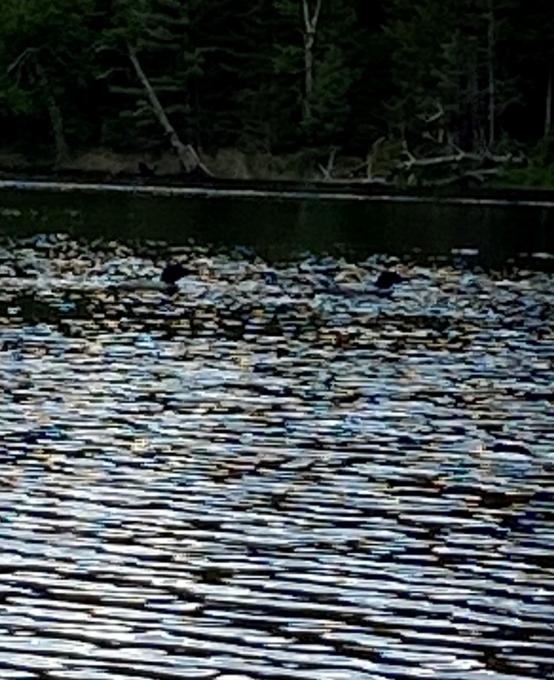The Cornell Lab Bird Academy › Discussion Groups › Joy of Birdwatching › Activities: Noticing Behaviors
-
Activity 1: While recently visiting the coast of North Carolina , I was able to observe a Great Egret fishing in the marsh. Standing stock still, or carefully moving through the water, he would tilt his head from side to side before quickly stabbing his beak into the water and pulling out small fish. Activity 2: My birdfeeder is such that only small birds are able to perch on it for any length of time. Chipping Sparrows are able to fit nicely and will stay and gorge themselves. Chickadees, while small, don't tend to stay long, opting instead to grab a seed and fly to a branch to sit and open it. White-throated Sparrows will perch on the feeder and also pick up seeds from the ground. Other ground feeders include Northern Cardinals, Mourning Doves and Dark-eyed Juncos. Birds that take from the feeder include Tufted Titmice, White-breasted Nuthatches and even Downy and Hairy Woodpeckers who hang on just long enough to grab a seed and go. Activity 3: While sitting in my backyard I identified the following birds by their songs. Tufted Titmouse, American Crow, Northern Cardinal, American Goldfinch, White-Breasted Nuthatch and either a Red-shouldered Hawk or a Blue Jay. Using the Merlin App, I was able to determine that I had missed identifying a Northern Flicker.
-
Activity #3: This morning in Eastern Ontario, I could hear the calls from Red-winged Blackbirds, Northern Cardinals and American Robins.

-
Activity 3: I spent a summer in Chincoteague VA a few years ago. I was a fee collector for the national wildlife refuge there. I remember sitting in the booth with the window open listening to the woods around me. I heard and saw a prothonotary warbler, I heard a few brown headed nuthatches in the canopy of pine trees around me. I heard the common call of cardinals. I saw a few other warblers that I couldn't quite figure out what they were. I heard and was able to identify a with sound ID a red headed woodpecker before I saw it flit from a tree.
-
Activity 2: The bird feeder in my parents backyard always has a bunch of activity. From blue jays and cardinals, grackles and doves to the seasonal warblers and painted bunting. Jays and grackles are big for the feeder so they will grab and go. cardinals will land for a few minutes or will fly to the fence 3 feet away. Mourning doves normally hangout on the ground and grab what other birds have knocked off the feeder. The warblers won't stay long on the feeder taking what they grab to the oak tree on the other side of the yard. Painted buntings will sometime sit and eat but seem to be easily scared off and will retreat to a near by bush or tree.
-
Activity 1: The other day I was watching some mourning doves outside my window, they were walking around looking for seeds and mealworms that I throw in the grass occasionally so my cats have something to look at through the window. The mourning doves were finding bits here and there. A blue jay became interested and tried to bully the doves out of the way and the doves stood there ground. A few minutes later, I believe it was, a crow came next, one of the doves began to put a wing up and flapped it once or twice. I know shore birds to do this to lure predators away from their nest. The mourning dove didn't have a nest there, but only one mourning dove did this behavior so i wonder if this mourning dove tried to divert the crows attention to itself instead of its partner.
-
Activity 2: watching the bird feeder today, I noticed in a mixed flock of black capped chickadees, nuthatches, titmice, and woodpeckers the chickadees visited the feeder the most and the titmice would kick them off of the feeder. The nuthatches spent less time at the feeder, and the woodpeckers didn’t visit the feeder at all.
-
Activity 1: My children and I came upon a group of Sparrows yesterday, and even my kids wanted to stay and watch them for a while. They were flying up to a ledge where they were bathing - we could see the water droplets flying off the edge - then they would fly down to another surface that was getting full sun (it was a lovely sunny day yesterday, even though there is snow on the ground). They would sit in the sun, preening their feathers, and fluffing themselves up. The kids thought they were adorable. At one point, a large bird flew overhead (it might have been a Red-tailed Hawk) and all the Sparrows immediately flew down to the ground behind some shrubs. I didn't notice any alarm calls, it happened so suddenly, but I must have just missed them! Activity 3: Earlier during the same walk, through a forested area backing onto a school , I heard several bird calls. I recognized the American Crows, the Northern Cardinals, the Black-capped Chickadees, and the House Sparrows. I heard two other calls that I didn't recognize, so I used Merlin for those and found they were Hairy Woodpeckers and White-breasted Nuthatches.
-
Still Activity 2: While typing, even more birds came by! A few Goldfinches came to grab seeds and fly off, and some Black-capped Chickadees did the same. Several Cardinals came to the trough, but didn't stay long. Activity 3: On the same birdcam, we heard the Chickadees before they actually appeared. We heard the Blue Jays call to one another from time to time. And there was the constant chatter of the Mourning Doves. I tried out the Sound ID function on Merlin, and it picked up the Goldfinches, but I had a hard time hearing that through the Mourning Doves.
-
Activity 2: Watching the Cornell Bird Cam, we noticed there were lots of Mourning Doves eating from the trough, gathering together. We saw Blue Jays swooping in to grab a peanut and fly off with it again. We saw some Starlings eating from the suet, and we saw a Hairy Woodpecker on the log-like feeder, eating from the holes, then later maybe a Downy Woodpecker. The Mourning Doves seemed to be spending the most time at the feeder, the Woodpeckers were in and out quickly, as were the Jays. The Starlings hung around for quite some time on the suet.
-
With winter here, I've been getting a lot of Dark-Eyed Juncos at my feeders. I noticed that they preferred to eat the seeds the House Finches had knocked off the feeder on the ground. I started to put seeds on the ground and many of them have started eating there more. I've put out a little cement slab for them to eat it off of instead of the snow. these are one of my all-time favorite birds and I'm very glad to have attracted more to my home :)
-
It always amazes me that the 2 (M&F) Cardinals that come to my feeders never show up at the same time. Since it is winter, they are probably not caring for a nest. I watch and watch, but one shows up, then disappears, then the other shows up.....but never at the same time. There are 3 gregarious Blue Jays that almost always arrive at the feeders at the same time. They hang in the branches of the big tree, drop down for a seed and then back to the branches. The WB Nuthatch always eats upside down at the seed feeder, but the downy always eats right side up at the suet feeder. There is a group of House Finches that eats regularly. I suppose there could be a Purple Finch in there once in a while. However, the one that I suspect moves so quickly that I cannot get a good look at the bird. The House Finches are happy to sit and eat and eat. I am able to focus on every detail. The one suspect bird is in and out and not to be identified.
-
Watched the Panama cam, saw a group of 6 Grey-Headed Chachalaca feeding on the fruits present, while 2 or 3 would dip their heads down, the others kept their heads up, then they would alternate. These are larger birds and they muscled out the smaller blue and red birds who were briefly present. They eat by grabbing and ripping the fruit, primarily bananas.
-
#2. House sparrows mob the feeder, bull their way on, and get shoved off. Doves sit and eat until another dove displaces them. Chickadees pick through the sunflower chips, take one to a bush, eat it there, and come back for more. Blue jays swoop in, eat quickly, and zoom away. Grackles sometimes grab multiple chips, dunk them in the water dish, repeat, and then fly away. Most birds get out of the way of the downy woodpeckers, and everyone gives the red-bellied woodpeckers plenty of space.
-
Night time at the Panama feeder. Humming bird would flit in feed for a second or two then fly off quickly out of picture frame.
-
Activity 2: I observed a White-Breasted Nuthatch take one peanut at a time and dart away with it to eat in privacy. The Tufted Titmouse also did the same at the seed feeder. One seed, then off he goes returning several times to the feeder. The Carolina Wren sat in the window feeder with the meal worms and had a feast. He is loud and makes a mess when eating. The Bluebirds do the same. The House Finches will sit on the perch at the feeder and take their time as well as the Chipping Sparrows. The Chickadees don’t sit as long as the Finches or Sparrows, but they will rest for a minute to eat on the feeder and then fly off. If they are eating peanuts they will take one at a time and leave, returning several times to the peanuts. The Downy Woodpeckers will hang on the suet feeders and take their time enjoying their meal. The Red-Bellied Woodpeckers will go to the no mess seed feeder and take seeds and leave.
-
A couple American Goldfinch in my garden on Oct 14. The plumage is a lot different then the goldfinch in spring or summer. They were picking seeds that I had thrown in there. They were competing with White Crown warbler dark eye junco and black chickadee
-


-
 On the subject of Goldfinches….they have been busy around my house. My husband was sitting in the driveway and called me from the car to tell me there were Goldfinches on my Zinnias! I grabbed my phone and peeked out the window and caught this picture! There were three or four of them dining on my flowers, picking off the petals and eating the seeds. Again I went to All about Birds to check out their diets and eating habits and sure enough, they like to land on plants (like thistles) and eat the seeds. It was hard to be mad at them. They are nesting now and I guess they were hungry!
On the subject of Goldfinches….they have been busy around my house. My husband was sitting in the driveway and called me from the car to tell me there were Goldfinches on my Zinnias! I grabbed my phone and peeked out the window and caught this picture! There were three or four of them dining on my flowers, picking off the petals and eating the seeds. Again I went to All about Birds to check out their diets and eating habits and sure enough, they like to land on plants (like thistles) and eat the seeds. It was hard to be mad at them. They are nesting now and I guess they were hungry! -
I witnessed two American Goldfinches outside my kitchen window doing something I have never seen before. I saw the female sitting on top of my neighbors arborvitae shrub bobbing it’s head and picking at the leaves. I looked closer and realized she was gathering the spider webs that were visible at the top of the shrub. I saw the male sitting nearby. She flew off and he followed her. A few minutes later she returned with her mate and repeated the same activity. I just looked up the nesting section for American Goldfinches at All About Birds and read that, indeed, they do use “spider silk” in building their nests. I suspected that was what it was for, but glad I was able to read about it as well. So interesting to watch!
-
ACTIVITY 1: A few weeks ago I saw two Warbling Vireos for the first time. One had some sort of caterpillar/larva in its mouth. I found them in a swamp, bouncing around on branches about 20 feet up. Then they did something that astonished me. Apparently during courtship they will get close and join beaks. The two I saw did this. Now one had a caterpillar in its mouth so maybe the other was just trying to steal it. But after joining beaks they fell several feet in a controlled descent, spinning like slow helicopter blades around their linked beaks. Their rapidly flapping wings gave them just enough lift to make this display seem intentional. I haven't been able to find anything about warbling vireos dropping through the air linked together and spinning, so perhaps this was an accident on their part but I was happy to have seen it. I've had several encounters with male Red-winged Blackbirds letting me know I was too close to their harems. They puff up get close, flash those red shoulders, make a racket, and stare daggers. I have a few photos of this. Finally, I was able to observe a few Eastern Wood-Pewees catching large Horse Flies. Two of these Pewees flew at me to catch their prey. The first got so close I felt the wind from its wings on my face. It rapidly turned away, landed on a branch, and gobbled down a massive horse fly. I guess he saved me from a bite. After swallowing the fly, the pewee brushed his beak on the branch on both sides, I guess using it as a napkin. A few minutes later I another Pewee demonstrating aerial maneuvers worthy of an air show, caught an even larger horse fly. The pewee landed on a branch holding the Horse Fly by its abdomen. The fly was buzzing its wings in a vain attempt to escape. To stop this, the Pewee slammed the fly into the branch several times. I did activity 2 and 3 but this entry has been long enough.
-
 An angry Red-Winged Blackbird telling me to get away from his harem.
An angry Red-Winged Blackbird telling me to get away from his harem. -
Thanks so much for these lovely descriptions! I'm especially interested in the vireos and hoping someone has more knowledge on these behaviors. And I could certainly visualize those pee-wees gobbling flies!
-
-
We have absolutely loved using the Sound ID on the Merlin Bird ID App. We have been able to ID so many birds because of it! Carolina Wrens, Cardinals, Tufted Titmouse, Northern Mockingbird, Eastern Bluebird, Red-Eyed Vireo, Scarlet Tanager, Acadian Flycatcher, Black-Throated Green Warbler and so many more!
-
First, thank you to everyone who takes the time to write. Very enjoyable. Second, a query. Via ebird, we have been noticing a local who does a lot of birding. We would love to make a connection with her. Is there any way to contact people you find in your county. We live in Franklin County, NY--very rural (not a lot of birding organizations) in the Adirondacks. This person also seems more experienced but is walking in the same remote areas we walk. Any ideas? We wrote Cornell lab but heard nothing..Yet! Activity 1 We have feeders all over the place. We notice the chickadees who are there all winter, are gone. Lots of mourning doves, red winged blackbirds, robins, and a dark blue headed blackbird--name? etc.. Interestingly, and this happens every year, we generally only get 1 hummingbird (at a time) at the feeders. Activity 2-We have suet in the backyard; we changed because something (raccoon) carried the whole thing away in the front yard (at least we cannot find the container). For us, it is interesting to see how the birds eat that suet--knocking a bit to the ground and then eating. Also, in the past, the black-capped chickadee is so interesting how they take the seed in their feet and then turn around to eat on the feeder. Chickadees also seem fearless! Activity 3-We used Merlin in the woods behind out house (live on 20 acres). Merlin identified Red-eyed vireo and eastern wood-peewee two birds of which we were unaware. Finally, and sorry so long, here is a pic of the first loons we have seen of the season. Kayak trip on Mountain Pond in the Adirondacks near out house.

-
Activity 1: I have been observing a Northern Mocking hanging on a power line in front of a house. I think it is the same individual. It sings its long repertoire of songs and calls by itself. While I walk along the street he sings very loud and sometimes it flies in a circle over the wire and returns to the same spot. Activity 2: Mourning Doves and European Starlings were picking the seeds from the ground, Common Grackles elevate their head to forage in the panel that was perpendicular to the ground, Red-bellied Woodpeckers were reaching the food from the trunk-like structure in the feeder. Activity 3: Depending on the time of the day, very early in the morning when it is still dark I hear Mourning Doves and House Sparrows. Later in the day I hear Blue Jays, Northern Cardinals, and House Sparrows, and in the afternoon I hear Gray Catbirds in addition to the ones I have heard earlier during the day.
-
Activity #1: It rained last night in the city. I have been watching the American Robins foraging in neighborhood lawns. One used its bill to probe around in the grass and then pulled up an earthworm. It hopped over to another location and began to swallow the worm.
-
1. I watched a Robin sitting on an electric wire. He sat for a while, not singing but lifting one wing and (it looked like) scratching under it. I learned from your video that birds do scratch their itches. I have also watched robins and sparrows wash themselves in a container of water in our backyard. 2. Behavior at our sunflower seed feeder does vary: a number of sparrows come, eat for a while and then head for a hedge; the resident cardinal pair flies from a bush, eats at the feeder (where the sparrows sometimes get aggressive) and on the ground; the one chickadee swoops in for a seed and then flies to a tree branch to eat it. 3. Early one morning, I turned on Merlin and then forgot about it-in 20 minutes 17 birds were identified, mostly common ones to this area. Earlier this spring (May 5) in a nearby park with a stream, Merlin identified 28 different species, including five kinds of Warblers, an Indigo Bunting, two Orioles, an American Redstart, a Waterthrush and a Yellow-breasted Chat!
Read More:
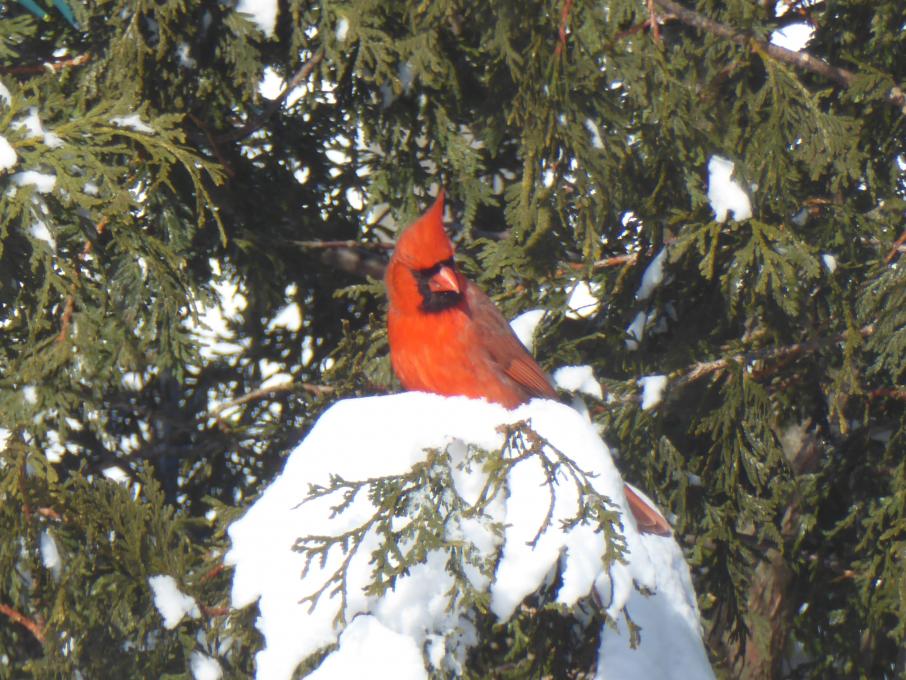
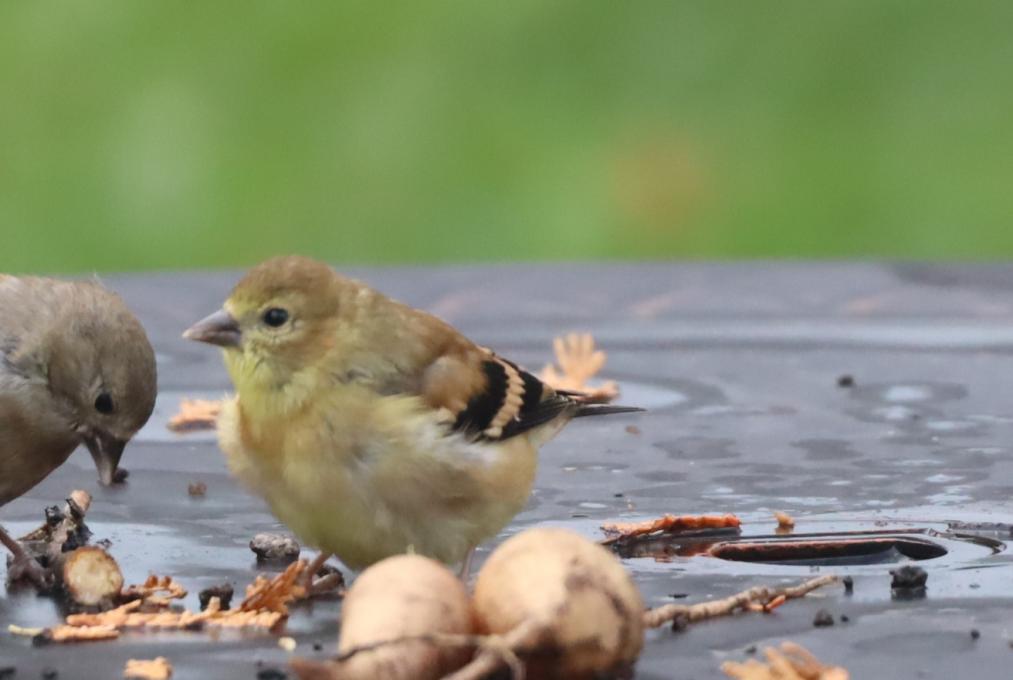
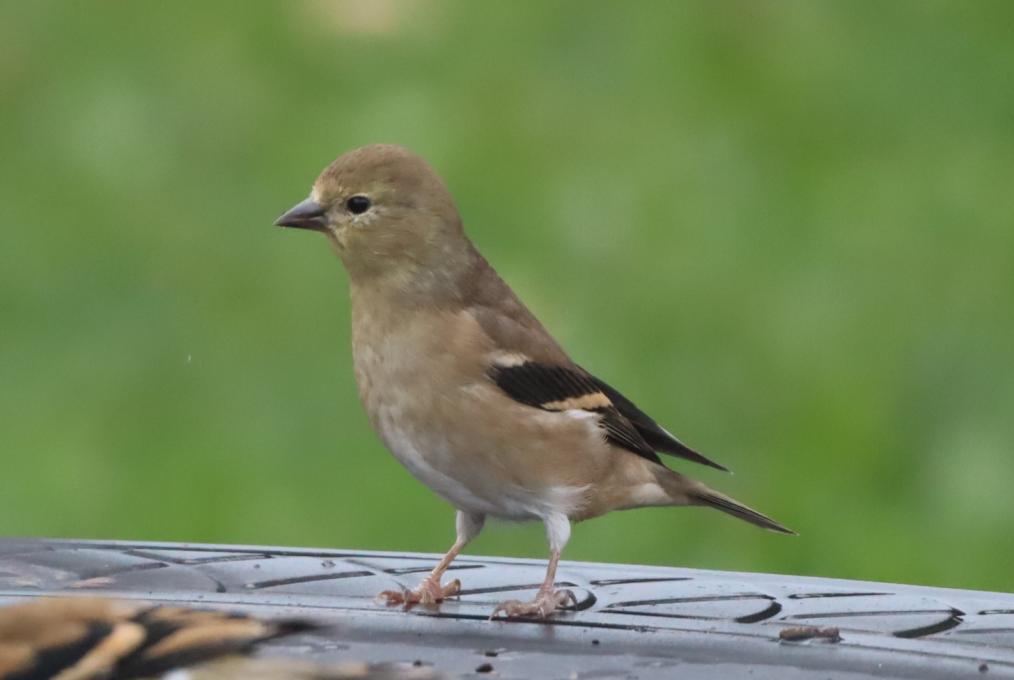
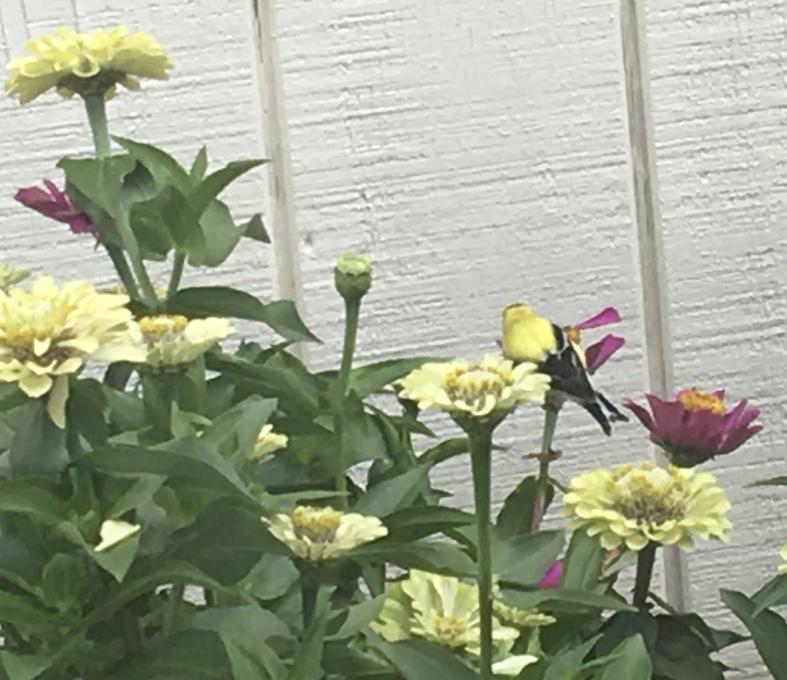 On the subject of Goldfinches….they have been busy around my house. My husband was sitting in the driveway and called me from the car to tell me there were Goldfinches on my Zinnias! I grabbed my phone and peeked out the window and caught this picture! There were three or four of them dining on my flowers, picking off the petals and eating the seeds. Again I went to All about Birds to check out their diets and eating habits and sure enough, they like to land on plants (like thistles) and eat the seeds. It was hard to be mad at them. They are nesting now and I guess they were hungry!
On the subject of Goldfinches….they have been busy around my house. My husband was sitting in the driveway and called me from the car to tell me there were Goldfinches on my Zinnias! I grabbed my phone and peeked out the window and caught this picture! There were three or four of them dining on my flowers, picking off the petals and eating the seeds. Again I went to All about Birds to check out their diets and eating habits and sure enough, they like to land on plants (like thistles) and eat the seeds. It was hard to be mad at them. They are nesting now and I guess they were hungry! 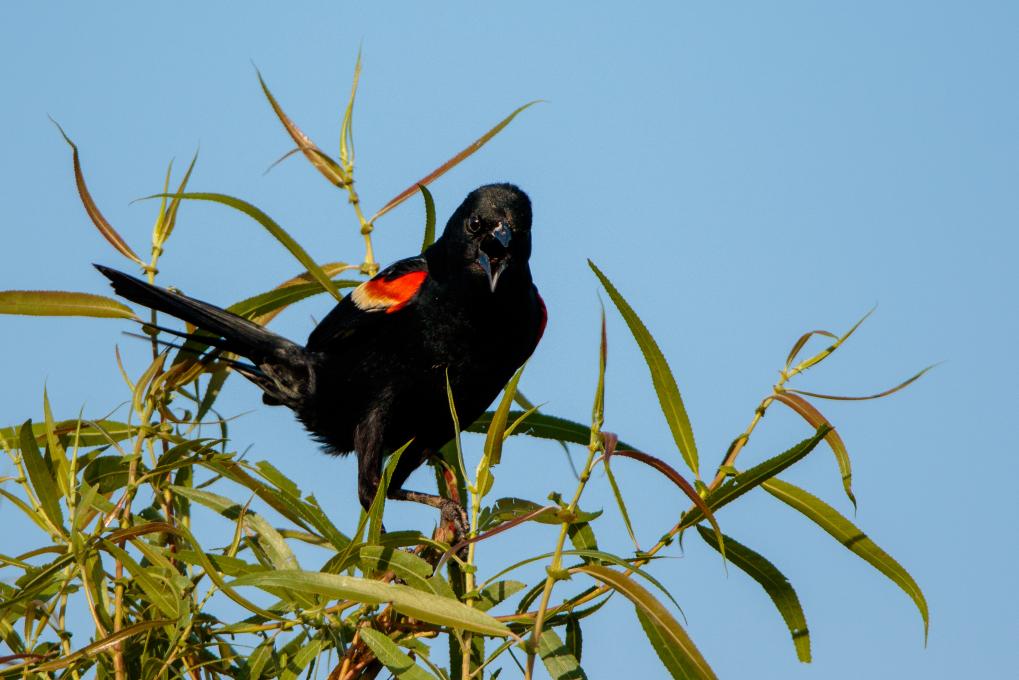 An angry Red-Winged Blackbird telling me to get away from his harem.
An angry Red-Winged Blackbird telling me to get away from his harem. 